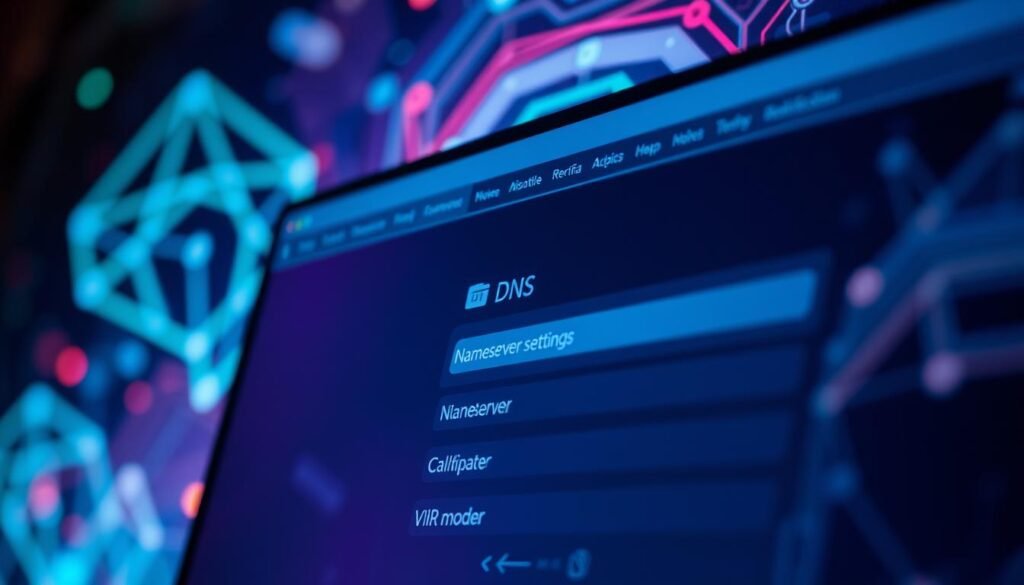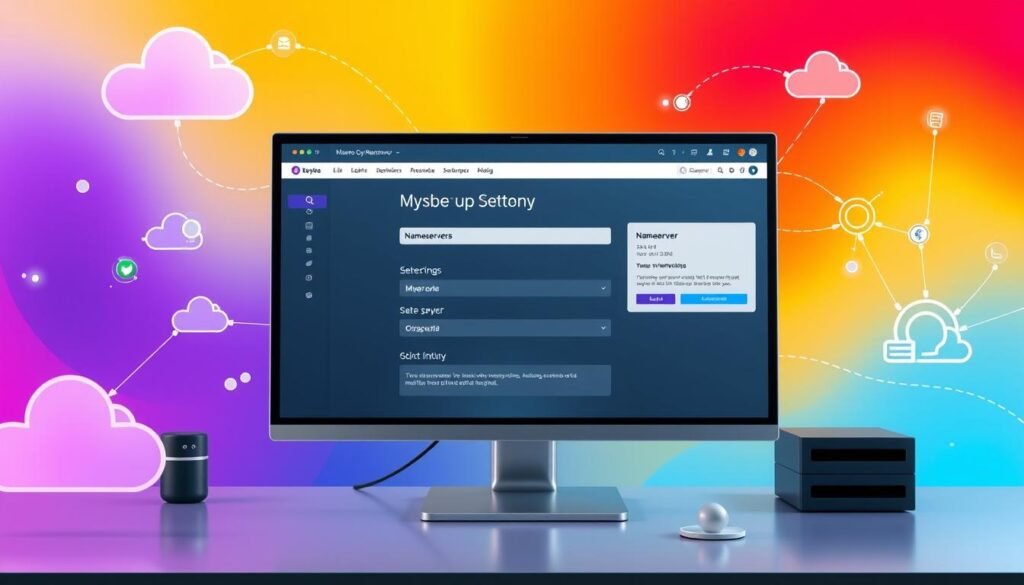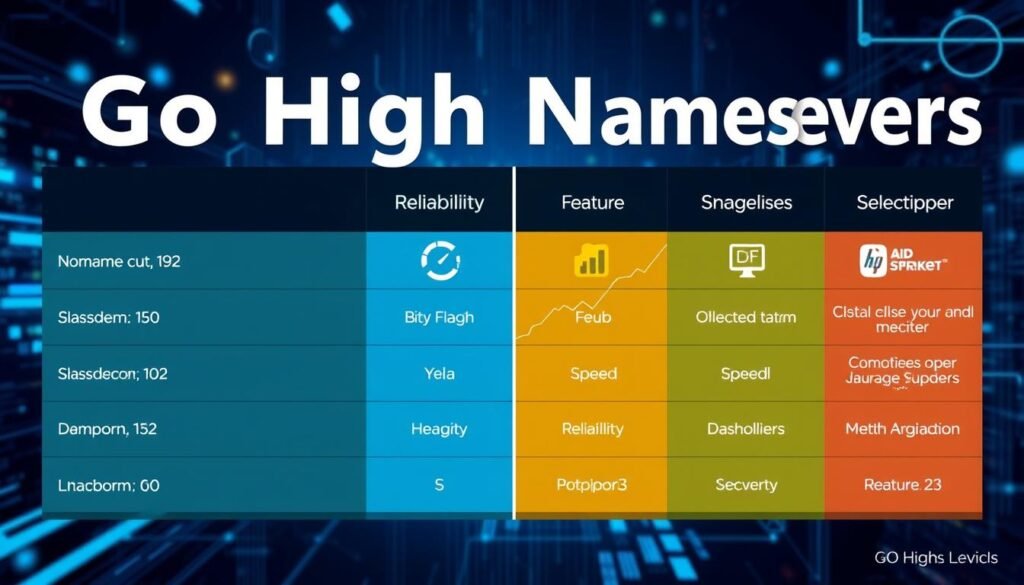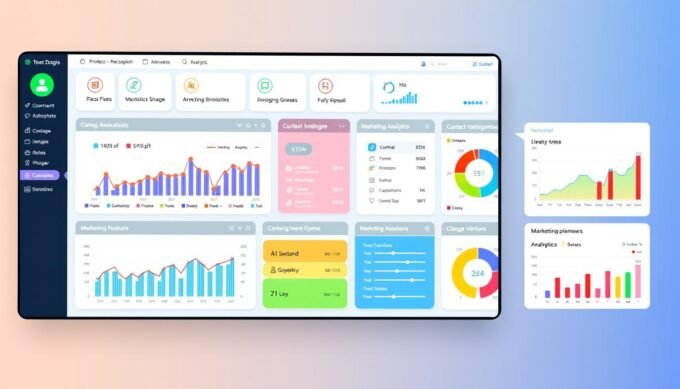Welcome to the digital world where your domain is like a lighthouse for clients on the internet. Ever seen an error message on a website and got stuck? Maybe you want to make your site faster or better? If that’s the case, Go High Level Nameservers are key to your online base. They’re not just tech tasks. They ensure your visitors connect smoothly with your content. The technical side might seem scary, but I’ll help you understand Go High Level domain settings. I’ll show you why controlling Go High Level hosting can be crucial for your success online.
Ever bought a domain and just left it, not knowing how it works? That’s common. We often don’t use domains to their full potential. They sit unused, like parked cars. But, with the right nameserver, your site can turn into a powerful marketing tool. Let’s dive into how domain settings work. From ‘A record’ to ‘CNAME record’, and avoiding SSL errors, every step matters.
Think of nameservers as the internet’s phonebooks. Without them, we’d have to remember every site’s IP address. Nameservers do more than help us remember; they help your site stand out online.
For years, I’ve helped people and companies set up their nameservers. Even a small detail can greatly improve your site’s performance. But many don’t realize how important domain setup is. It’s as crucial as the site’s content. I want to shed light on this. Let’s make sure your domain isn’t just there, but it’s a powerhouse.
Key Takeaways
- Grasping the vital role nameservers play in connecting your domain to Go High Level hosting is fundamental.
- A methodical approach to configuring Go High Level domain settings can avert typical mistakes that may derail your online presence.
- Be mindful that every domain or subdomain you own is a unique online real estate that requires careful handling and setup.
- Awareness of the intricacies of DNS record propagation and timely error handling can save your site from downtime drama.
- Revel in the simplicity and automation of the Go High Level DNS system, which eradicates guesswork and technical overwhelm for domain integration.
- Recognize that your choice in nameservers can have significant SEO implications, giving you the edge in your digital marketing efforts.
- Remember, a well-oiled domain with a seamless nameserver setup is your silent ally, tirelessly working to enhance user experience and brand credibility.
What Are Nameservers in Go High Level?
Today’s digital world needs strong support to keep a good Go High Level online presence. Knowing what nameservers do is crucial. They act like traffic directors on the internet. Nameservers change the domain names we know into IP addresses. This lets computers understand each other and talk over the web.
Understanding the Basics of Nameservers
A nameserver is a special internet server. It answers questions about where a domain’s services are located. These servers play a big role in setting up Go High Level servers. They make sure email and web visits go to the right place. By connecting domain names to IP addresses, nameservers ensure online requests go where they should.
How Nameservers Work with Your Domain
Adding nameservers to your domain is a key step for your online start. When you register with Go High Level, nameservers help direct your emails and web traffic. This setup helps visitors use your site without trouble. DNS propagation also matters. It updates networks with your nameserver info, helping set up your online identity.
Below, you’ll find a table comparing A records and CNAME records. Both are key for setting up Go High Level nameservers:
| Record Type | Description | Usage |
|---|---|---|
| A Record | Points a domain or subdomain to a specific IP address provided by Go High Level. | Direct routing of traffic to an IP address, typically used for main domains. |
| CNAME Record | Points a domain or subdomain to another domain name, instead of an IP address. | Suitable for subdomains, allowing for easier changes and management. |
In summary, nameservers and DNS records are key for a strong Go High Level online presence. They ensure visitors find your digital space.
Setting Up Go High Level Nameservers
Setting up nameservers for your Go High Level site might seem hard at first. But with the right steps, it becomes easy. This setup is crucial for email services or making a professional business profile. Understanding each step well ensures your setup is effective and efficient.
Step-by-Step Guide to Configure Nameservers
Getting started is simple if your domain is from Google, GoDaddy, or Cloudflare. These platforms have automatic setup features. For other providers, you’ll need to set things up manually. Let’s look at how you can do this:
- Identify the type of domain: Know if it’s for a blog, a client portal, or a whitelabel domain. This helps decide which DNS settings to use.
- Choose the record type: Depending on your host, pick an A record for root domains or a CNAME for subdomains.
- Configure DNS settings: Enter the DNS configurations like record types and values manually. Set TTL to 5 minutes for fast propagation.
- Add the domain to Go High Level: After setting DNS, add your domain to your Go High Level sub-account. Link it with the right funnel or website.
- Verify the setup: Use tools like MXtoolbox to check if DNS settings are correctly spread. This could take 24 to 48 hours.
- Final confirmation: In your Go High Level dashboard, look for a “Verified” status. It shows your domain setup is right. SSL certificate issuance usually happens in 1 to 10 minutes.
Common Mistakes to Avoid
Even with Go High Level’s good system, mistakes can mess up the setup. Especially if you lack Go High Level tech support. Here are errors to avoid:
- Incomplete DNS Propagation: Sometimes, changes are made before the DNS settings fully spread. You must wait the full 24 to 48 hours.
- Duplicate A Records: Having more than one A record for a domain causes DNS conflicts. This makes the domain unresolvable.
- Incorrect DNS Entry: A small mistake in DNS settings can cause big problems. Always double-check your entries.
In the end, setting up nameservers for your Go High Level domain is key for managing your online presence. By carefully following the guide and avoiding common mistakes, you can ensure a smooth and successful setup. This keeps your site and communications professional and reliable.
Importance of Choosing the Right Nameservers
When you set up a website, picking the right nameservers is crucial. It directly affects your website’s speed and how well it does in search rankings. Nameservers guide internet traffic to your site. This makes sure users can get to your site fast and without problems. This is key for making your hosting work well.
Impact on Website Performance
Nameservers play a big role in how fast your website can start up for someone visiting. With Go High Level hosting, choosing strong nameservers helps your site respond quicker and gives a better experience to visitors. Websites that load quickly are not just good for keeping users happy. They also do better in search engine rankings.
How Nameservers Affect SEO
Good nameservers mean your site is up and running well, which is important for SEO. Search engines prefer sites that are quick to load and always available. Setting up your nameservers right helps with accessibility and is important for SEO. Mistakes can cause errors, hurting your site’s ranking and user experience.

Picking the right nameservers helps keep your site safe from attacks. This keeps your site’s ranking high. Let’s look at some common nameservers used:
| Nameserver Provider | Typical Configuration Attributes |
|---|---|
| Google Public DNS | Global coverage, emphasizing speed and security |
| Cloudflare | Focuses on performance with additional options for web optimizations |
| GoDaddy | Easy integration with domain registration services |
| Bluehost | Optimized for WordPress sites with emphasis on ease of use |
| AWS Route 53 | Highly scalable and designed for enterprise-level hosting |
Choosing nameservers wisely boosts Go High Level hosting efficiency. This highlights how important nameservers are for web speed and SEO.
DNS Records and Their Role
Understanding Go High Level DNS records is key to using domain settings well. These records make sure internet traffic flows right. They keep emails, websites, and services running smoothly.
Types of DNS Records You Need to Know
DNS records have different types. For example, an A record links my domain to an IP address. It’s crucial for people to reach my website. CNAME records let one domain point to another. This is great for handling subdomains. MX records are for email. TXT records help with online safety, like with SPF and DKIM.
How to Manage DNS Records in Go High Level
Managing Go High Level DNS records takes careful work. It’s about making sure all linked services work right. I often check and update records to keep up with Internet changes.
To adjust records, I login to Go High Level. Then, I go to domain settings. There, I can change or add records. Doing this prevents service breaks and keeps everything running fast.
Let’s look more at these records:
| Type | Purpose | Example Use Case |
|---|---|---|
| A | Links a domain to an IPv4 address | Directing traffic to a web server |
| AAAA | Links a domain to an IPv6 address | Future-proofing for newer IP technology |
| CNAME | Aliases one domain to another | Managing multiple service subdomains |
| MX | Defines mail exchange servers | Routing emails to correct email servers |
| TXT | Stores arbitrary text linked to a domain | Verifying domain ownership |
In conclusion, handling DNS records in Go High Level is crucial. It’s not just about connections. It’s also about security and reliability online. With knowledge and tools, I control my domain’s traffic well.
Troubleshooting Nameserver Issues
When you’re working with Go High Level server configuration, running into nameserver problems can seem tough. But finding the exact issue and fixing it is key. Luckily, Go High Level technical support is here to help, keeping your business running smoothly.
Identifying Common Problems
Nameserver issues mainly come from wrong DNS settings or delays in propagation. You might see SSL errors from bad installs or missing DNS records due to non-propagation. Knowing these problems is the first step to fixing them. For example, if nameservers don’t resolve, it can really affect your site’s access. Check out more on this here.
Tips for Resolving DNS Conflicts
Here’s how you can fix DNS conflicts:
- Check DNS records: Make sure all your domain/subdomain records are right. Watch out for duplicates that could mess things up.
- Fix Cloudflare settings: If you use Go High Level, change Cloudflare proxy to ‘DNS only’ for correct DNS handling.
- Use DNS tools: Tools like GRC’s DNS Nameserver Performance Benchmark can help you pick the best DNS provider.

Fixing these problems means looking at both server and client sides to catch all potential errors.
If you often change DNS records, consider DNS scavenging. Just be careful not to accidentally delete important records, which could take your site down.
With the right strategies, dealing with Go High Level server configuration gets easier. This way, your site stays up and runs well. And remember, if things get tricky, Go High Level technical support is always there to help you through any nameserver troubles.
How to Verify Your Nameserver Setup
It’s important to make sure your Go High Level DNS settings are correct. This helps keep your online presence up and running. Checking your nameserver setup correctly talks to the internet. This step is key to prevent downtime and keep things moving smoothly.
Tools to Check Nameserver Propagation
There are great online tools for making sure DNS changes are working well. Understanding DNS lingo helps in reading their results. MXtoolbox is one such tool I use to confirm different records. DNS Checker and Google have tools I rely on for DNS status updates worldwide.
What to Do If Verification Fails
If checking fails, first ensure your DNS records are right and up to date. Sometimes, you just need to wait a bit longer for changes to spread. In cases of wrong propagation, you can use DNSMap to see DNS status globally. If problems arise with Cloudflare, switch proxy settings to ‘DNS only’. This is because Go High Level DNS doesn’t work with some proxy features.
Linking your domain with Go High Level can improve your website’s efficiency. With 77 million domains under its belt, GoDaddy shows the robustness of Go High Level. Checks should show if your services on Go High Level are smoothly integrated. This ensures your operations run well.

Always check your DNS settings, especially after making changes. This keeps your Go High Level online presence strong and efficient. It’s crucial for success in the digital world today.
Benefits of Using Go High Level Nameservers
Using Go High Level hosting and Go High Level website management with their Nameservers boosts efficiency and reliability. These tools make managing domain services better. Let’s see why they improve user experience so much.
Streamlined Setup Process
The setup with Go High Level Nameservers is easy. Setting up nameservers can be hard, but Go High Level makes it simpler. This helps a lot when you’re working with different domain registrars like Google, GoDaddy, and Cloudflare.
For example, setting up a dedicated sending domain with Go High Level is automated. You add your domain details and verify it across DNS providers easily. The whole process is fast, usually done in 24 hours. This way, businesses can get their email marketing going quickly.

Enhanced Support and Resources
Go High Level also offers great support and resources. This is super helpful, especially for new users or when problems arise. If a domain is pointing to another email server, Go High Level’s guidance helps fix it without trouble.
The platform gives detailed help with DNS management too. This includes how to get SSL certificates or set up dedicated IPs. These tips help keep your website running smoothly and securely.
| Feature | Benefit | Completion Time |
|---|---|---|
| Automated domain configuration | Simplifies initial setup | 24 hours |
| DNS Management | Optimized web performance and security | Varies |
| Enhanced Technical Support | Assistance with setup and troubleshooting | Available 24/7 |
| Custom SSL Configuration | Enhanced site security | 48 hours or less |
Go High Level hosting is great for many industries, like e-commerce, marketing, and SaaS. It offers DNS and server management tailored to any business size. With Go High Level, your online presence is strong and reliable.
Comparing Go High Level Nameservers to Others
When looking into nameserver options, think about how they fit with web management. I picked Go High Level’s nameserver services because I compared features. I mainly looked at Go High Level SEO optimization and server setup.
Pros and Cons of Various Providers
Different DNS providers vary in services. Understanding these differences helps in making a good choice. Here’s a look at how Go High Level’s nameserver service stacks up against other DNS providers.
| Feature | Go High Level | Other Providers |
|---|---|---|
| Auto Setup for Registrars | Yes | Limited |
| Integrated SSL Deployment | Yes | No |
| User Guides | Comprehensive | Basic |
| Support for Subdomains | Extensive | Varies |
| Marketing Tools Integration | Advanced | Basic |
Why I Chose Go High Level
I chose Go High Level for its top-notch approach to server setup and SEO. It provides a smooth nameserver setup for digital marketers. This helps a lot with managing big online projects.
From my review and experience, Go High Level boosts site performance and reliability. Both are key for SEO. Plus, its easy marketing tools integration helps manage campaigns smoothly.

Go High Level stands out by meeting the needs of digital marketing folks with innovative server and SEO strategies. This makes it a top pick for those focused on online success through tech.
Best Practices for Managing Nameservers
If you handle digital properties, knowing the best ways to manage Go High Level nameservers is key. It helps with security and keeps your internet presence stable. These methods boost website performance and make Go High Level domain settings and support more reliable.
Regular Updates and Monitoring
Keep up with new configurations and check your DNS records often. It avoids issues that could mess with your site. By doing regular updates, your domain will point to the right spots. This stops possible downtimes.
Ensuring Security and Stability
It’s critical to keep your security tough. Update NS records and use good DNSSEC protocols. This way, Go High Level’s support team can fix problems fast. It keeps your online space strong.
| DNS Record Type | Description | Impact on Website |
|---|---|---|
| A Records | Maps domain names to IP addresses (IPv4) | Crucial for the basic accessibility of websites |
| CNAME Records | Alias for one domain to another | Allows more flexible domain management |
| MX Records | Directs email to an email server | Essential for correct email delivery |
| TXT Records | Stores text information for various services | Supports security features like SPF and DKIM |
| NS Records | Identifies authoritative nameservers for the domain | Key for DNS querying process |
| AAAA Records | Links domain names to IP addresses (IPv6) | Future-proofs your site for next-gen IP addresses |
Using these steps improves Go High Level domain settings and makes a reliable space for users. This guide helps prevent issues and keeps your digital world running smoothly. All this is strongly backed by Go High Level technical support.
Advanced Features of Go High Level Nameservers
Go High Level nameserver management offers advanced features for agencies and marketers. They further improve online presence using Go High Level server setup and API integration. These features boost control and efficiency in domain and DNS services management.
Custom Nameservers Explained
Go High Level lets users create custom nameservers. This aids in branding, helping businesses look unified online. Custom nameservers boost trust and professionalism, important for winning stakeholder confidence.
API Integration with DNS Services
Go High Level API integration offers flexible DNS settings management. It adapts to different marketing strategies and user needs in real time. This functionality is key for handling large networks and ensuring fast, reliable service.
Many businesses choose Go High Level for more than basic functions. Around 82% of agencies WhiteLabel and personalize the software, showcasing Go High Level’s high customization ability.
Agencies using Go High Level report impressive average monthly revenue. With affordable tools, businesses can grow without worrying about technical details.
To wrap up, using Go High Level’s custom nameservers and API integration makes online presence more effective. It offers a reliable, scalable, and custom-fit web made for each brand’s needs. Go High Level simplifies complex server settings, offering easy-to-use solutions.
Frequently Asked Questions about Nameservers
Handling nameservers is key for a strong online presence and dependable support. I often get questions on nameserver management. I’ll cover the most common queries below.
What to do if my website is down?
Is your website not loading? First, check DNS propagation to make sure there are no delays with your nameservers. If that looks fine, examine your DNS settings for any issues. Running a Go High Level diagnostic or reaching out to support can quickly solve the problem. Their team is ready to get your site back up.
Can I change nameservers without downtime?
Changing nameservers worries many because of possible downtime. But, a careful plan can prevent issues. First, set up the new nameservers with your current DNS records. Then, update them at your registrar and keep an eye on the switch. Changes can happen quickly, but sometimes they take up to 48 hours.
Using Go High Level’s reliable DNS can help avoid site visibility problems during this transition. Checking a DNS failure table can offer extra help and answers:
| DNS Query Type | Occurrence | Notes |
|---|---|---|
| A Records (IPv4) | High | Commonly looked up by clients |
| AAAA Records (IPv6) | Increasing | Shows a move towards IPv6 |
| CNAME Records | Common | Looked up when A record fails |
| Failed Queries at Root Servers | Notable | Shows why iterative queries are needed |
With the right preparation and Go High Level’s help, you can switch nameservers smoothly, avoiding downtime.
Conclusion: My Experience with Go High Level Nameservers
During my time exploring Go High Level hosting, I learned a lot about nameservers. They play a crucial role in managing and optimizing domains. My adventure started with hopes of easier DNS management. It ended with outcomes that met my hopes. Go High Level’s domain settings make my web presence stronger. They also helped make my site load faster and more reliable.
Final Thoughts on Optimizing Your Domains
The Domain Connect feature changed the game for me. It made linking my domains to various services smoother. The platform works well with big names like Google Domains and GoDaddy. But that’s not all. As a Cloudflare user, I had to tweak DNS records to turn off the proxy feature. Although changes might take 30 seconds or more, the benefits are worth it. Connecting domains to WordPress and email services becomes easy.
Choosing the right TTL value for DNS settings is critical. It affects how quickly updates spread across the internet. This delicate balance enhances your site’s speed and how it responds. Go High Level’s SEO improvements are top-notch, creating a well-working digital world.
Encouragement for Users to Explore Features
If you’re starting with Go High Level, dive into all it offers. You can automate or handle settings manually to boost your site’s SEO and performance. For those who see DNS errors, set up a routine to check on them. Just because there’s no error doesn’t mean everything is fine. Being proactive is essential. With Go High Level, a vast domain world is at your fingertips, offering stability and reach.
FAQ
What are Go High Level Nameservers?
How can I set up Go High Level Nameservers?
How do nameservers impact my website’s performance and SEO?
What are the different types of DNS records and their roles?
How can I troubleshoot nameserver issues in Go High Level?
What should I do if my Go High Level nameserver verification fails?
What are the benefits of using Go High Level Nameservers?
Why should I choose Go High Level Nameservers over others?
Can I maintain regular updates and monitoring on my Go High Level nameservers to manage them effectively?
What advanced features do Go High Level Nameservers offer?
What if my Go High Level hosted website goes down?
Is it possible to change my Go High Level Nameservers without causing downtime?
How can I ensure my domain’s security and stability within Go High Level?
Should users new to Go High Level take time to learn about nameserver management?
Source Links
- How to set up Root Domain/Subdomain for your Funnels/Websites?
- Setting up Whitelabel Domain, API Domain, Email Sending Domain, Sites Domain, Client Portal Domain & more
- GoHighLevel Nameservers
- How to Connect a Domain in GoHighLevel: A Comprehensive Guide for 2023
- GoHighLevel Domain Setup: Your Essential Guide for 2024
- How to Add a Domain and Verify DNS Records
- What Is a Nameserver? Why Are Nameservers Important?
- What Is a Nameserver, and Why Does It Matter? Here’s What I Know…
- What are Top level domain server in DNS.Wants to understand its significance in real time network traffic
- DNS Records Explained | Gcore
- Guidance for troubleshooting DNS – Windows Server
- DNS root hints issue, unable to resolve domain
- How do registrars register authoritative name servers with root name servers?
- How to Connect GoDaddy Domain to GoHighLevel
- How to Set Up a Dedicated Sending Domain (LC Email)
- GoHighLevel Domain Setup | GoHighLevel Info
- How to set up the Client Portal?
- Key Differences Between Authoritative and Recursive DNS Nameservers – Anycast.com
- What are the types of DNS servers?
- What Are Nameservers? And Why Do They Matter?
- Understanding Nameservers: How They Work and Why They Matter
- Nameservers: What Are They And How Do They Work?
- GoHighLevel Domain Name Setup 2024: Essential Steps For Online Success – Ray O’Daniel
- How to Setup, Customize, and Manage Your Communities
- Cloudflare Setup for GoHighLevel – Growthable
- What has priority: nameservers or a records?
- What is a name server for a domain? – AUQ.io
- Frequently Asked Questions | Quad9
- How to use the Domain Connect feature?
- DNS TTL Values: Tutorial & Best Practices
- How to Troubleshoot DNS Errors (Timeouts, Codes & More)













